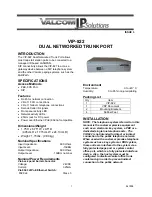
Parameter
Description
STP Status
Use the pull-down menu to enable or disable STP globally on the Switch.The default is
Disabled
.
STP Version
Use the pull-down menu to choose the desired version of STP to be implemented on the Switch.There are
three choices:
STP
– Select this parameter to set the Spanning Tree Protocol (STP) globally on the switch.
RSTP
– Select this parameter to set the Rapid Spanning Tree Protocol (RSTP) globally on the Switch.
MSTP
– Select this parameter to set the Multiple Spanning Tree Protocol (MSTP) globally on the Switch.
Hello Time: (
1-10 sec
)
The
Hello Time
can be set from 1 to 10 seconds.This is the interval between two transmissions of BPDU
packets sent by the Root Bridge to tell all other switches that it is indeed the Root Bridge.This field will only
appear here when STP or RSTP is selected for the STP Version. For MSTP, the Hello Time must be set on a port
per port basis. See the MST Port Settings section for further details.
Max Age: (
6 - 40 sec
)
The
Max Age
may be set to ensure that old information does not endlessly circulate through redundant
paths in the network, preventing the effective propagation of the new information. Set by the Root Bridge, this
value will aid in determining that the Switch has spanning tree configuration values consistent with other
devices on the bridged LAN. If the value ages out and a BPDU has still not been received from the Root Bridge,
the Switch will start sending its own BPDU to all other switches for permission to become the Root Bridge. If
it turns out that your switch has the lowest Bridge Identifier, it will become the Root Bridge.The user may
choose a time between 6 and 40 seconds.The default value is 20.
Forward Delay: (
4 – 30 sec
)
The
Forward Delay
can be from 4 to 30 seconds.Any port on the Switch spends this time in the listening
state while moving from the blocking state to the forwarding state.
Max Hops (1-20)
Used to set the number of hops between devices in a spanning tree region before the BPDU (bridge protocol
data unit) packet sent by the Switch will be discarded. Each switch on the hop count will reduce the hop count
by one until the value reaches zero.The Switch will then discard the BDPU packet and the information held for
the port will age out.The user may set a hop count from 1 to 20.The default is 20.
TX Hold Count (1-10)
Used to set the maximum number of Hello packets transmitted per interval.The count can be specified from 1
to 10.The default is 3.
Forwarding BPDU
This field can be
Enabled
or
Disabled
.When
Enabled
, it allows the forwarding of STP BPDU packets from other
network devices.The default is
Enabled
.
Click
Apply
to implement changes made.
Note:
The Hello Time cannot be longer than the Max.Age. Otherwise, a configuration error will occur. Observe the following formulas when
setting the above parameters:
Max.Age ≤ 2 x (Forward Delay - 1 second)
Max.Age ≤ 2 x (Hello Time + 1 second)
MST Configuration Table
The following screens in the
MST Configuration Table
window allow the user to configure a MSTI instance on the Switch.These settings will uniquely
identify a multiple spanning tree instance set on the Switch.The Switch initially possesses one
CIST
or Common Internal Spanning Tree of which the user may
modify the parameters for but cannot change the MSTI ID for, and cannot be deleted.To view the
Current MST Configuration Identification
window,
click
Configuration > Spanning Tree > MST Configuration Table
:
Figure 6- 24. Current MST Configuration Identification window
45
Allied Telesyn AT-9724TS High-Density Layer 3 Stackable Gigabit Ethernet Switch
















































